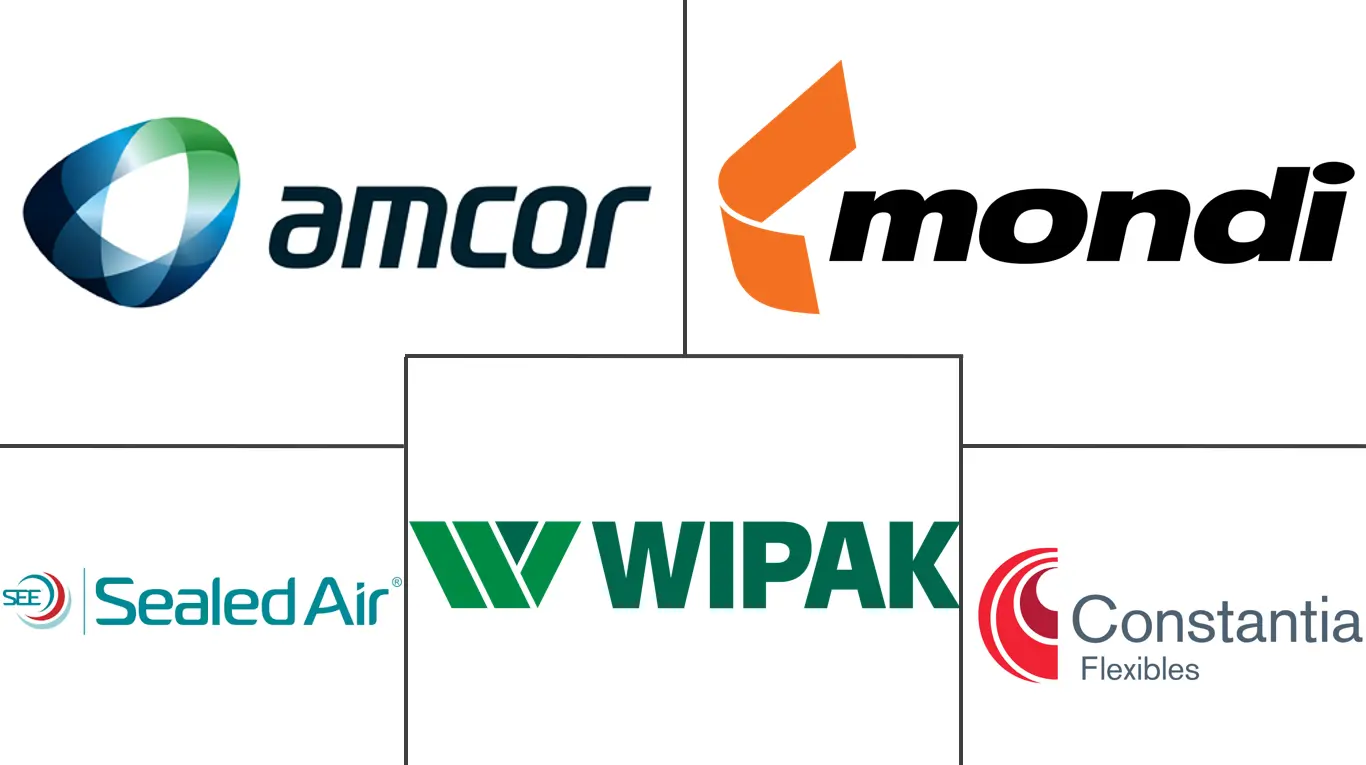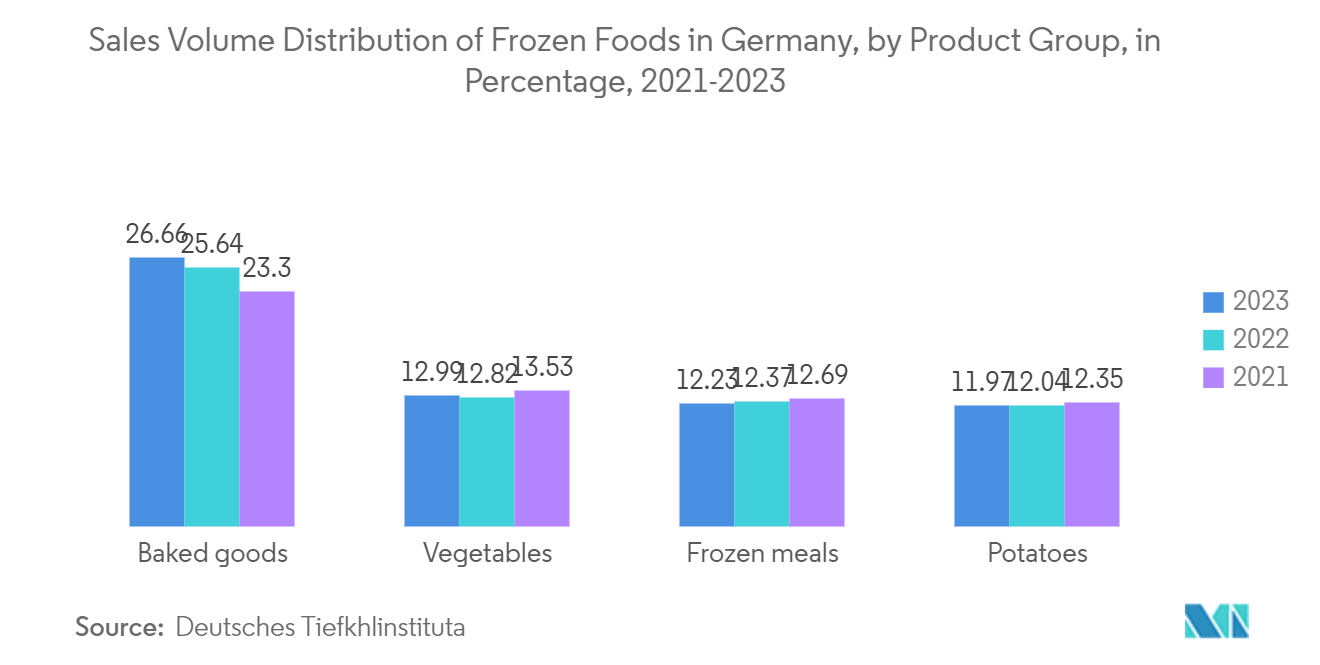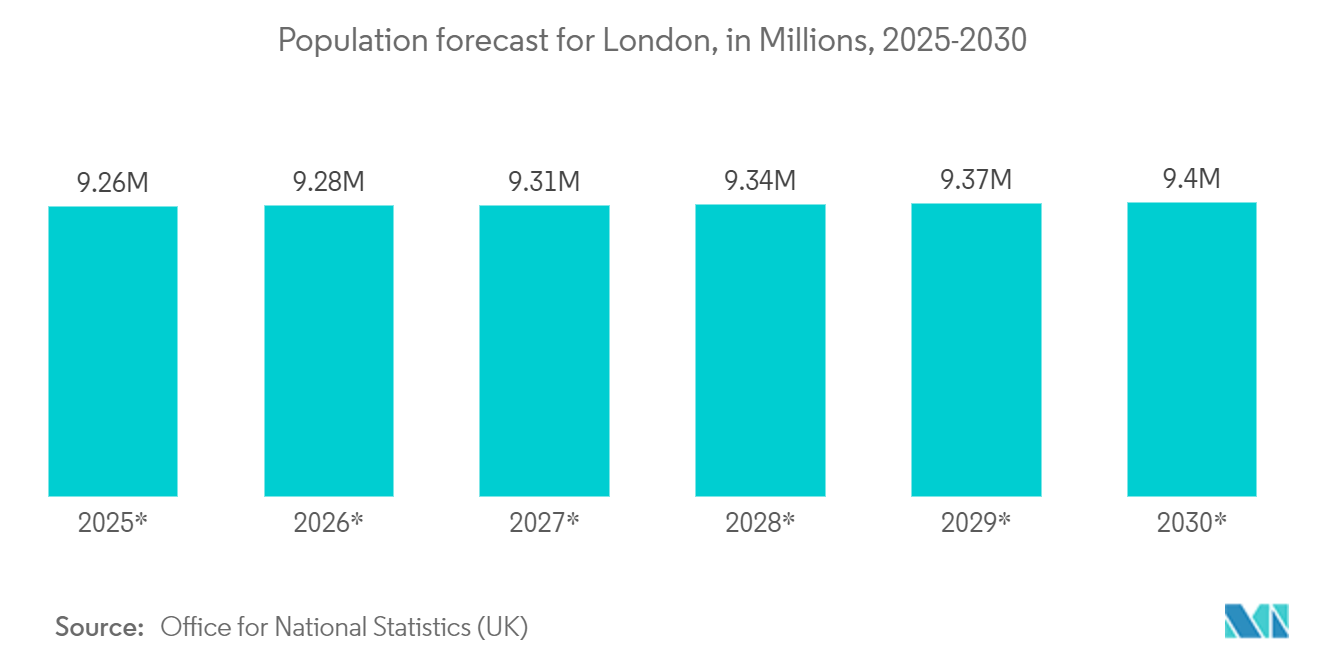Europe Flexible Packaging Market Size

| Study Period | 2019 - 2029 |
| Base Year For Estimation | 2023 |
| Market Size (2024) | USD 60.16 Billion |
| Market Size (2029) | USD 76.81 Billion |
| CAGR (2024 - 2029) | 5.01 % |
| Market Concentration | Medium |
Major Players
*Disclaimer: Major Players sorted in no particular order |
Europe Flexible Packaging Market Analysis
The Europe Flexible Packaging Market size is estimated at USD 60.16 billion in 2024, and is expected to reach USD 76.81 billion by 2029, growing at a CAGR of 5.01% during the forecast period (2024-2029).
Growing demand for processed, conveniently packaged, and pre-prepared foods and snacks in Europe will expand the market. This trend is also fueled by the continent's expanding urban population and shifting lifestyle habits, such as less time spent on meal preparation.
- Furthermore, because flexible packaging solutions can extend the shelf life of such products, the demand for packaged foods, ready-to-eat meals, frozen foods, and luxury foods is anticipated to rise in the nation. The emergence of sustainable, flexible packaging solutions has also been aided by rising consumer desire for product personalization and rising demand from food and beverage industries for recyclable and eco-friendly packaging.
- Owing to the region's fast-changing lifestyles and economic expansion, the preference for processed and packaged goods has driven the market for food packaging. The primary cause of the rising appetite for processed foods is the population's movement from rural to urban locations. However, the amount of plastic packaging waste in the area is rising (by 2% annually). The EU Commission is considering outlawing all plastic packaging, which is predicted to slow market expansion. According to Virginijus Sinkevicius, the incoming EU commissioner for the environment, plastic packaging and the use of recovered plastic would be outlawed.
- The dairy industry is one of many that uses plastic and concentrates on using less plastic. Lord Rooker, the United Kingdom's Food and Farming Minister, has urged the dairy industry to become more sustainable, with a 50% reduction in the number of plastics used in milk packaging. That suggests that greener packaging will continue to expand in a nation that has already demonstrated innovation diversity.
- The expanding cosmetics sector backs the market in France. For their cosmetic items, several well-known brands are choosing flexible packaging materials. Flexible solutions are more affordable and have a longer shelf life than stiff plastic. Consequently, the expanding cosmetics industry is anticipated to open up the lucrative potential for the flexible packaging market.
- The European market may face difficulties due to the financial crisis's effects on consumer spending power, rising commodity prices, and other similar concerns. Modern infrastructure is required for the process of recycling plastic packaging waste. It is a time-consuming operation that demands personnel competence.
- Additionally, due to the widespread usage of plastic material for flexible packaging, specific environmental issues regarding recyclability and sustainability may marginally restrict the market growth. Recycling and disposal rules are becoming stricter in a number of European nations, which could provide a problem for some merchants there. All of these things limit the expansion of the European flexible packaging market.
Europe Flexible Packaging Market Trends
Food Segment is Expected to Drive the Flexible Packaging Market in the Region
- Flexible packaging is a lightweight alternative that saves costs associated with production, damage, parts, returns, disposal, and transportation by allowing material processors to ship more products in less quantity. This is the ideal solution for food packaging. In addition, many small businesses in the region are looking for better protection with longer shelf life against various types of food spoilage, such as air, moisture, and sunlight, increasing the demand for flexible packaging.
- The demand for packaged food products is rising quickly due to working professionals' growing time limitations and the availability of more convenient food options. Packaged food products provide better barrier protection, containment or accumulation, advertising, detailed ingredient information, safety, appropriateness, and other benefits. As a result, the demand for packaged foods and the growing inclination for online shopping is expected to drive growth in the worldwide e-commerce packaging market throughout the forecast period.
- According to research conducted by Voyado, the proportion of consumers who made their first-ever online grocery purchases during the pandemic is Spain at 30%, France at 22%, the United Kingdom and Italy at 20%., Sweden and Denmark at 14%, Finland at 11%, Poland, Netherlands, Belgium, Germany at 10%, and Norway at 9%. Also, 68% of new customers who buy groceries online confirmed that keep doing so in the future. Consequently, this shift in people's habits has positively impacted the barrier film packaging market.
- A study published in the British Food Journal revealed that families that switched to frozen food reduced their food waste by over 47%. As a result, consumers are also moving to frozen food to reduce the amount of trash they produce. This shift to frozen food will spur market expansion. The demand for frozen food bags is rising due to several causes, including changing lifestyles, increasing disposable income, and the quick urbanization of developing nations, particularly the expanding middle-class population.
- The rising trend towards e-commerce is driving the growth of the market. The expansion of e-commerce has significantly impacted the frozen food business in Europe. Online retailers are leveraging extensive digital capabilities to offer a wider range of frozen foods and ship them directly to consumers' homes, making it easier for customers to purchase and source these products. The convenience of home delivery, the ease of online ordering, and the possibility of real-time order tracking are all driving the expansion of the frozen food market.
- According to Deutsches Tiefkühlinstitut In the year 2023, frozen baked goods made up approximately 27 percent of frozen food sales - the largest portion in this category. Frozen vegetables came in second place with nearly 13 percent, while frozen meals (including stews and soups) came in third with about 12 percent across Germany
- Moreover, the rapid development of grocery chains, supermarkets, hypermarkets, and convenience stores and the increasing availability and quality of products are some of the primary drivers of the industry. In addition, the strong growth of the food industry and the rising employment rate is also important for the rapid growth of the frozen food industry in Europe.

United Kingdom to Witnesses Significant Growth Opportunities in the market
- Growing urban populations in the United Kingdom According to Office for National Statistics (UK) is projected that by 2030, the population of London will rise to 9.4 million, which represents a growth of 550,000 individuals from 2025.along with growth oa pouplationa nd their altered lifestyle patterns, such as less time spent on meal preparation, are driving a shift towards more processed, conveniently packaged, and pre-prepared foods and snacks, which is anticipated to drive the growth of the market under study.
- Additionally, because flexible packaging solutions can extend the shelf life of such products, the rising demand for packaged foods, ready-to-eat foods, frozen foods, and luxury foods is projected to enhance the need for these solutions nationwide.
- Due to a rise in demand for packaging services in the UK due to the rising industrial sector, the packaging industry is growing dramatically. The Packaging Federation of the United Kingdom estimates that the UK packaging manufacturing sector had yearly sales of GBP 11 billion (USD 13.59 billion). More than 85,000 people are employed there, which is 3% of the manufacturing workforce in the UK.
- The increased demand for flexible packaging solutions for tobacco, pet food, and homecare solutions drives the need for flexible packaging in the rest of the end-user verticals in the United Kingdom during the forecast period.
- In addition, the market is expected to be significantly impacted by the tightening of plastic usage laws. For instance, the United Kingdom's Plastic Packaging Tax (PPT), which went into effect on 1 April 2022, is charged at a rate of GBP 200 (USD 247.7) per metric ton of plastic packaging in the United Kingdom that has less than 30% recycled plastic content. The tax intends to promote the use of more environmentally friendly plastic packaging, boost the utilization of recycled plastic, and aid in reducing plastic waste.
- Consumers across the nation believe that e-commerce is not ecologically beneficial because of the gas emissions from deliveries and returns. In a survey conducted in 2022 by Aquapak, a manufacturer of specialized polymers that develops products to promote a circular economy, more than half (52%) of United Kingdom customers stated they would be ready to pay more for ecologically friendly packaging when buying clothing and accessories.
- One-third of those prepared to pay extra indicated they would increase the price by 1% to 4% to receive their items in sustainable packaging, while nearly two-fifths (39%) said they would pay an additional 5%. 15% of respondents said they would be willing to spend an extra 10% to 20%, while 8% said they would pay an additional 6% to 9%.

Europe Flexible Packaging Industry Overview
The Europe Flexible Packaging Market is semi-consolidated and dominated by major players like Amcor PLC, Mondi Group, Wipak Group, Huhtamaki Oyj, and Constantia Flexibles. These major players have a prominent share of the market and are focusing on expanding their customer base by leveraging strategic collaborative initiatives to increase their market share and profitability.
- April 2023 - Huhtamaki has expanded the boundaries of what is possible by employing science to create revolutionary mono-material technology. It is revolutionary, environmentally friendly, and flexible packaging in Paper, PE, and PP Retort that satisfies the needs of both its clients and their end users. These large-scale innovations will help customers fulfill pledges they have made, such as using only recyclable, biodegradable, or reusable packaging by 2025. They also align with the direction of future policy, both in the EU and internationally.
- August 2022 - Amcor has announced that it has completed the acquisition of a world-class flexible packaging plant in the Czech Republic. The company is involved in the development and production of environmental friendly packaging solutions. The site's strategic location immediately enhances Amcor's ability to meet growing customer demand and strong demand across its flexible packaging network in Europe.
Europe Flexible Packaging Market Leaders
-
Amcor PLC
-
Mondi Group
-
Wipak Group
-
Sealed Air
-
Constantia Flexibles
*Disclaimer: Major Players sorted in no particular order
.webp)
Europe Flexible Packaging Market News
- April 2023 - The ability to access innovative, sustainable packaging solutions is more important than ever as customers worldwide strive to shift to a circular, net-zero economy. Berry Global, which designs and produces innovative, sustainable packaging solutions, will begin developing its International Center of Excellence and Circular Innovation Hub in Barcelona, Spain, as early as the third quarter of 2023.
- April 2022 - Mondi launched new packaging solutions for the food industry at AnugaFoodTec in Cologne, Germany. Two-tray packaging products provide recyclable options for fresh food manufacturers, which will help to reduce food waste.PerFORMing Monoloopand Mono Formable PP will provide high-barrier food protection, demonstrating how packaging plays a vital role throughout the supply chain.
Europe Flexible Packaging Market Report - Table of Contents
1. INTRODUCTION
- 1.1 Study Assumptions and Market Definition
- 1.2 Scope of the Study
2. RESEARCH METHODOLOGY
3. EXECUTIVE SUMMARY
4. MARKET INSIGHTS
- 4.1 Market Overview
-
4.2 Industry Attractiveness - Porter's Five Forces Analysis
- 4.2.1 Bargaining Power of Suppliers
- 4.2.2 Bargaining Power of Consumers
- 4.2.3 Threat of New Entrants
- 4.2.4 Intensity of Competitive Rivalry
- 4.2.5 Threat of Substitute Products
- 4.3 Industry Value Chain Analysis
- 4.4 Assessment of the impact of COVID-19 on the market
5. MARKET DYNAMICS
-
5.1 Market Drivers
- 5.1.1 Steady Rise in Demand for Processed Food
- 5.1.2 Move Toward Light Weighting Expected to Spur Volume Demand
-
5.2 Market Challenges
- 5.2.1 Flexible Packaging is Increasingly Turning into a Competitive Marketplace which Could Impact the Growth Prospects of New Entrants
- 5.2.2 Environmental Challenges Related to Recycling
6. MARKET SEGMENTATION
-
6.1 By Material Type
- 6.1.1 Polyethene (PE)
- 6.1.2 Biaxially Oriented Polypropylene (BOPP)
- 6.1.3 Cast Polypropylene (CPP)
- 6.1.4 Polyvinyl Chloride (PVC)
- 6.1.5 PET
- 6.1.6 Other Material Types (EVOH, EVA, PA, etc.)
-
6.2 By Product Type
- 6.2.1 Pouches (Retort,Pouches, Stand-up Pouches, and Flat Pouches)
- 6.2.2 Bags (Gusseted and Wicketed)
- 6.2.3 Packaging Films
- 6.2.3.1 PE-based
- 6.2.3.2 BOPET
- 6.2.3.3 CPP and BOPP
- 6.2.3.4 PVC
- 6.2.3.5 Other Film Types
- 6.2.4 Other Product Types
-
6.3 By End-user Verticals
- 6.3.1 Food
- 6.3.1.1 Frozen Food
- 6.3.1.2 Dairy Products
- 6.3.1.3 Fruits and Vegetables
- 6.3.1.4 Other Food Products
- 6.3.2 Beverage
- 6.3.3 Healthcare and Pharmaceuticals
- 6.3.4 Cosmetics and Personal Care
- 6.3.5 Other End-user verticals
-
6.4 By Country
- 6.4.1 Western Europe
- 6.4.1.1 United Kingdom
- 6.4.1.2 Germany
- 6.4.1.3 France
- 6.4.1.4 Italy
- 6.4.1.5 Spain
- 6.4.2 Eastern and Central Europe
- 6.4.2.1 Poland
- 6.4.2.2 Czech Republic
- 6.4.2.3 Romania
- 6.4.2.4 Hungary
7. COMPETITIVE LANDSCAPE
-
7.1 Company Profiles
- 7.1.1 Amcor PLC
- 7.1.2 AL INVEST BA
- 7.1.3 Aluflexpack Group
- 7.1.4 Bak Ambalaj
- 7.1.5 Bischof + Klein SE & Co. KG
- 7.1.6 Constantia Flexibles
- 7.1.7 Cellografica Gerosa SpA
- 7.1.8 Coveris Holdings
- 7.1.9 Danaflex Group
- 7.1.10 Di Mauro Flexible Packaging
- 7.1.11 Gualapack SpA
- 7.1.12 Huhtamaki Oyj
- 7.1.13 ProAmpac LLC
- 7.1.14 Wipak Oy
- 7.1.15 Treofan group (Bc Jindal)
- 7.1.16 Sipospack
- 7.1.17 ePac Holdings LLC
- 7.1.18 Mondi Group
- 7.1.19 CDM Packaging
- 7.1.20 Schur Flexible
- 7.1.21 BERRY GLOBAL INC.
- 7.1.22 UFlex Limited
- *List Not Exhaustive
8. INVESTMENT ANALYSIS
9. FUTURE OF THE MARKET
** Subject To AvailablityEurope Flexible Packaging Industry Segmentation
The Europe Flexible Packaging Market combines the advantages of plastic, without compromising the product's printability, robustness, barrier protection, freshness, or ease of use. Due to its numerous energy and advantages, flexible packaging is also in higher demand.
Europe flexible packaging market is segmented by material type (polyethylene (PE), biaxially oriented polypropylene (BOPP). cast polypropylene (CPP), polyvinyl chloride (PVC), PET), by product type ((pouches (retort pouches, stand-up pouches, flat pouches), bags (gusseted and wicketed)), packaging films ( PE-based, BOPET, CPP and BOPP, PVC), by end-user vertical (food (frozen food, dairy products, fruits and vgetables), beverage, healthcare and pharmaceuticals, cosmetics and personal care), by country (Western Europe (United Kingdom, Germany, France, Italy, Spain, Rest of Western Europe), Eastern and Central Europe (Poland, Czech Republic, Romania, Hungary). The market sizes and forecasts are provided in terms of value (USD billion) for all the above segments.
| By Material Type | Polyethene (PE) | |
| Biaxially Oriented Polypropylene (BOPP) | ||
| Cast Polypropylene (CPP) | ||
| Polyvinyl Chloride (PVC) | ||
| PET | ||
| Other Material Types (EVOH, EVA, PA, etc.) | ||
| By Product Type | Pouches (Retort,Pouches, Stand-up Pouches, and Flat Pouches) | |
| Bags (Gusseted and Wicketed) | ||
| Packaging Films | PE-based | |
| BOPET | ||
| CPP and BOPP | ||
| PVC | ||
| Other Film Types | ||
| Other Product Types | ||
| By End-user Verticals | Food | Frozen Food |
| Dairy Products | ||
| Fruits and Vegetables | ||
| Other Food Products | ||
| By End-user Verticals | Beverage | |
| Healthcare and Pharmaceuticals | ||
| Cosmetics and Personal Care | ||
| Other End-user verticals | ||
| By Country | Western Europe | United Kingdom |
| Germany | ||
| France | ||
| Italy | ||
| Spain | ||
| By Country | Eastern and Central Europe | Poland |
| Czech Republic | ||
| Romania | ||
| Hungary |
Europe Flexible Packaging Market Research FAQs
How big is the Europe Flexible Packaging Market?
The Europe Flexible Packaging Market size is expected to reach USD 60.16 billion in 2024 and grow at a CAGR of 5.01% to reach USD 76.81 billion by 2029.
What is the current Europe Flexible Packaging Market size?
In 2024, the Europe Flexible Packaging Market size is expected to reach USD 60.16 billion.
Who are the key players in Europe Flexible Packaging Market?
Amcor PLC, Mondi Group, Wipak Group, Sealed Air and Constantia Flexibles are the major companies operating in the Europe Flexible Packaging Market.
What years does this Europe Flexible Packaging Market cover, and what was the market size in 2023?
In 2023, the Europe Flexible Packaging Market size was estimated at USD 57.15 billion. The report covers the Europe Flexible Packaging Market historical market size for years: 2019, 2020, 2021, 2022 and 2023. The report also forecasts the Europe Flexible Packaging Market size for years: 2024, 2025, 2026, 2027, 2028 and 2029.
Flexible Packaging in Europe Industry Report
Statistics for the 2024 Flexible Packaging in Europe market share, size and revenue growth rate, created by Mordor Intelligence™ Industry Reports. Flexible Packaging in Europe analysis includes a market forecast outlook to 2029 and historical overview. Get a sample of this industry analysis as a free report PDF download.



